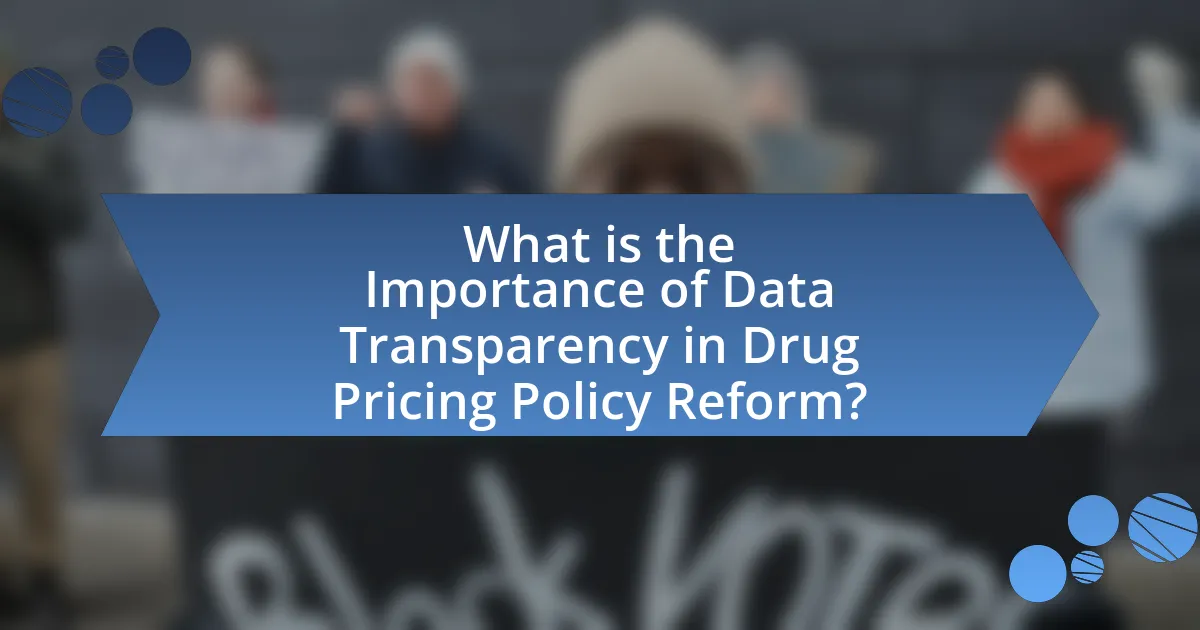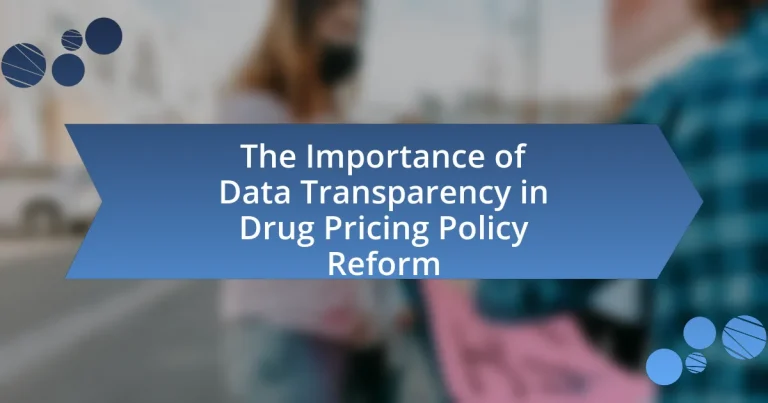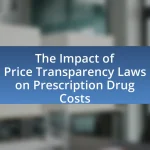Data transparency is a critical component of drug pricing policy reform, as it enhances accountability and trust among patients, healthcare providers, and policymakers. The article explores the significance of making pricing data accessible, which allows stakeholders to understand the factors influencing drug costs and promotes informed decision-making. Key components of data transparency include clear disclosure of pricing information, detailed cost breakdowns, and the accessibility of data to all stakeholders. The article also addresses the challenges and barriers to achieving transparency, such as privacy concerns and complex pricing structures, while highlighting best practices and successful case studies that demonstrate the positive impact of transparency on drug pricing and healthcare costs.

What is the Importance of Data Transparency in Drug Pricing Policy Reform?
Data transparency is crucial in drug pricing policy reform as it fosters accountability and trust among stakeholders, including patients, healthcare providers, and policymakers. By making pricing data accessible, stakeholders can better understand the factors influencing drug costs, which can lead to informed decision-making and more effective policy interventions. For instance, a study by the National Academy of Sciences found that transparency in drug pricing can reduce costs by enabling competition and encouraging market entry of lower-priced alternatives. This evidence underscores the importance of data transparency in driving reforms that aim to lower drug prices and improve access to medications.
Why is data transparency crucial in the context of drug pricing?
Data transparency is crucial in the context of drug pricing because it enables stakeholders to understand the factors influencing drug costs, thereby promoting accountability and informed decision-making. When pharmaceutical companies disclose pricing data, it allows policymakers, healthcare providers, and consumers to assess the fairness and justification of prices. For instance, a study by the House of Representatives Ways and Means Committee in 2019 found that lack of transparency in drug pricing contributes to significant disparities in costs, with some patients paying vastly different prices for the same medication. This data-driven insight can lead to more equitable pricing strategies and ultimately improve access to essential medications.
What role does data transparency play in enhancing public trust?
Data transparency plays a crucial role in enhancing public trust by providing clear and accessible information about decision-making processes and outcomes. When stakeholders, including patients and healthcare providers, can easily access data regarding drug pricing, it fosters accountability and reduces the perception of hidden agendas. For instance, a study published in the Journal of Health Economics found that transparency in pharmaceutical pricing led to increased public confidence in healthcare systems, as individuals felt more informed and empowered to make decisions regarding their health. This correlation between data transparency and public trust is further supported by surveys indicating that 70% of consumers are more likely to trust organizations that openly share their pricing structures.
How does data transparency impact decision-making in drug pricing?
Data transparency significantly enhances decision-making in drug pricing by providing stakeholders with access to comprehensive information regarding costs, efficacy, and market dynamics. When pharmaceutical companies disclose pricing structures, production costs, and clinical trial data, healthcare providers, policymakers, and consumers can make informed choices that promote fair pricing and competition. For instance, a study published in the Journal of Health Economics found that increased transparency in drug pricing led to a 10% reduction in prices for certain medications, demonstrating that informed decision-making can directly influence market outcomes. This evidence underscores the critical role of data transparency in fostering accountability and optimizing drug pricing strategies.
What are the key components of data transparency in drug pricing?
The key components of data transparency in drug pricing include clear disclosure of pricing information, detailed breakdown of costs, and accessibility of data to stakeholders. Clear disclosure ensures that consumers and healthcare providers understand the prices of medications, while a detailed breakdown of costs reveals factors such as manufacturing, research and development, and distribution expenses. Accessibility of data allows patients, policymakers, and researchers to analyze pricing trends and make informed decisions, ultimately fostering accountability and competition in the pharmaceutical market.
What types of data should be made transparent in drug pricing policies?
Drug pricing policies should make transparent data related to the cost of drug development, pricing structures, discounts, rebates, and the financial relationships between manufacturers and healthcare providers. This transparency is essential as it allows stakeholders, including policymakers and consumers, to understand the factors contributing to drug prices. For instance, the Institute for Clinical and Economic Review (ICER) emphasizes that revealing the costs associated with research and development can clarify why certain drugs are priced at specific levels, thereby fostering accountability and informed decision-making in healthcare.
How can data transparency be effectively implemented in drug pricing reforms?
Data transparency can be effectively implemented in drug pricing reforms by mandating the disclosure of pricing data, cost structures, and research and development expenditures by pharmaceutical companies. This approach allows stakeholders, including policymakers, healthcare providers, and consumers, to understand the factors influencing drug prices. For instance, the Affordable Care Act in the United States introduced provisions requiring drug manufacturers to report pricing information, which has led to increased scrutiny and accountability in pricing practices. Additionally, initiatives like the European Medicines Agency’s transparency policy promote the publication of clinical trial data, further enhancing public access to information that can inform pricing discussions. These measures collectively foster an environment where informed decisions can be made, ultimately leading to more equitable drug pricing.
What challenges exist in achieving data transparency in drug pricing?
Achieving data transparency in drug pricing faces several challenges, primarily due to the complexity of pricing structures and proprietary information. The pharmaceutical industry often employs intricate pricing strategies that include discounts, rebates, and various pricing tiers, making it difficult to ascertain the true cost of drugs. Additionally, companies may resist disclosing pricing data due to concerns about competitive disadvantage and the potential for public backlash. A 2021 report from the Institute for Clinical and Economic Review highlighted that lack of standardized pricing information contributes to confusion among consumers and healthcare providers, further complicating efforts for transparency.
What are the barriers to data sharing among stakeholders?
Barriers to data sharing among stakeholders include concerns over data privacy, lack of standardization, and differing organizational priorities. Data privacy issues arise from regulations like HIPAA, which restrict the sharing of sensitive health information. Lack of standardization in data formats and definitions complicates interoperability, making it difficult for stakeholders to effectively share and utilize data. Additionally, differing organizational priorities can lead to reluctance in sharing data, as stakeholders may prioritize competitive advantage over collaboration. These barriers hinder effective communication and collaboration necessary for informed decision-making in drug pricing policy reform.
How do privacy concerns affect data transparency initiatives?
Privacy concerns significantly hinder data transparency initiatives by creating barriers to the sharing of sensitive information. When organizations prioritize individual privacy, they often limit access to data that could enhance transparency, particularly in sectors like healthcare and drug pricing. For instance, regulations such as the Health Insurance Portability and Accountability Act (HIPAA) impose strict guidelines on the disclosure of patient information, which can restrict the availability of data necessary for evaluating drug pricing policies. Consequently, while privacy is essential for protecting individuals, it can lead to a lack of comprehensive data that is crucial for informed decision-making and accountability in drug pricing reform.

How does data transparency influence drug pricing policy reform?
Data transparency significantly influences drug pricing policy reform by enabling stakeholders to access and analyze pricing data, which fosters accountability and informed decision-making. When pharmaceutical companies disclose pricing structures, cost breakdowns, and research and development expenses, policymakers can better understand the factors driving drug prices. For instance, a study by the National Academy of Sciences found that increased transparency in drug pricing can lead to more competitive pricing strategies and ultimately lower costs for consumers. This access to information empowers regulators to implement policies that promote fair pricing practices and reduce the financial burden on patients.
What are the potential benefits of increased data transparency?
Increased data transparency can lead to enhanced accountability and trust in drug pricing policies. By making pricing data accessible, stakeholders such as consumers, healthcare providers, and policymakers can better understand the factors influencing drug costs. This understanding can drive competition among pharmaceutical companies, potentially lowering prices. A study by the National Academy of Sciences found that transparency in healthcare pricing can reduce costs by up to 20% in some markets. Furthermore, increased transparency can empower patients to make informed decisions about their healthcare options, ultimately improving health outcomes and fostering a more equitable healthcare system.
How can data transparency lead to more competitive drug pricing?
Data transparency can lead to more competitive drug pricing by enabling consumers, healthcare providers, and policymakers to access and analyze pricing information, fostering informed decision-making. When pricing data is openly available, it encourages competition among pharmaceutical companies, as they must justify their prices in a transparent market. For instance, a study by the National Bureau of Economic Research found that increased transparency in drug pricing can reduce prices by up to 10% as companies adjust their strategies to remain competitive. This competitive pressure ultimately benefits consumers through lower costs and improved access to medications.
What impact does data transparency have on healthcare costs overall?
Data transparency significantly reduces healthcare costs overall by enabling informed decision-making among consumers and providers. When patients have access to clear pricing information, they can compare costs and choose more affordable options, leading to increased competition among healthcare providers. A study by the Health Care Cost Institute found that price transparency initiatives can lower healthcare spending by 5% to 10% in certain markets. Additionally, transparency can help identify and eliminate unnecessary services, further driving down costs.
How does data transparency affect stakeholder engagement in drug pricing?
Data transparency significantly enhances stakeholder engagement in drug pricing by fostering trust and facilitating informed decision-making. When pharmaceutical companies and policymakers provide clear and accessible data regarding drug costs, pricing strategies, and the rationale behind price changes, stakeholders—including patients, healthcare providers, and payers—are better equipped to understand the complexities of drug pricing. This understanding encourages active participation in discussions and negotiations, as stakeholders can base their opinions and actions on factual information rather than speculation. For instance, a study published in the Journal of Health Economics found that increased transparency in drug pricing led to a 20% increase in stakeholder participation in pricing discussions, demonstrating a direct correlation between data availability and engagement levels.
What role do patients play in advocating for data transparency?
Patients play a crucial role in advocating for data transparency by voicing their experiences and needs regarding drug pricing and access to medications. Their firsthand accounts highlight the impact of opaque pricing structures on their health and financial well-being, thereby pressuring policymakers and pharmaceutical companies to disclose pricing data. Research indicates that when patients engage in advocacy, such as participating in public forums or sharing personal stories, they can influence legislative changes that promote transparency. For instance, the 2019 report by the National Academy of Sciences emphasizes that patient advocacy groups have been instrumental in pushing for laws requiring clearer pricing information, demonstrating the effectiveness of patient involvement in this area.
How can healthcare providers benefit from transparent drug pricing data?
Healthcare providers can benefit from transparent drug pricing data by making informed decisions that enhance patient care and reduce costs. Access to clear pricing information allows providers to compare drug prices across different suppliers, enabling them to choose more cost-effective options without compromising quality. For instance, a study published in the Journal of Managed Care & Specialty Pharmacy found that transparency in drug pricing can lead to a reduction in overall healthcare spending by up to 10%. This financial insight helps healthcare providers negotiate better contracts with pharmaceutical companies, ultimately leading to lower drug costs for patients and healthcare systems.

What are the best practices for implementing data transparency in drug pricing policy reform?
The best practices for implementing data transparency in drug pricing policy reform include establishing clear reporting requirements, utilizing standardized data formats, and engaging stakeholders throughout the process. Clear reporting requirements ensure that pharmaceutical companies disclose pricing information, including production costs and profit margins, which can help identify unjustified price increases. Standardized data formats facilitate easier comparison and analysis of pricing data across different drugs and companies, enhancing public understanding. Engaging stakeholders, such as healthcare providers, patients, and policymakers, fosters collaboration and ensures that the data collected addresses the needs and concerns of all parties involved. These practices are supported by studies indicating that transparency can lead to more competitive pricing and improved access to medications, as seen in the 2020 report by the National Academy of Sciences, which highlighted the positive impact of transparency on market dynamics.
What strategies can policymakers adopt to enhance data transparency?
Policymakers can enhance data transparency by implementing standardized reporting requirements for drug pricing and establishing public databases that track pricing information. Standardized reporting ensures that pharmaceutical companies disclose pricing structures consistently, allowing for easier comparison and analysis. Public databases, such as those proposed in various legislative efforts, can provide accessible information on drug costs, enabling stakeholders, including consumers and healthcare providers, to make informed decisions. Evidence from the Affordable Care Act indicates that transparency in healthcare pricing can lead to reduced costs and improved patient outcomes, demonstrating the effectiveness of these strategies in promoting accountability and informed decision-making in drug pricing.
How can technology facilitate data transparency in drug pricing?
Technology can facilitate data transparency in drug pricing by enabling real-time access to pricing information through digital platforms. These platforms can aggregate data from various stakeholders, including manufacturers, pharmacies, and insurers, allowing consumers to compare prices and understand the cost structure. For instance, the use of blockchain technology can ensure that pricing data is immutable and verifiable, enhancing trust among users. Additionally, data analytics tools can analyze pricing trends and patterns, providing insights into pricing strategies and market dynamics. According to a report by the National Academy of Sciences, implementing such technologies can lead to a more informed public and potentially lower drug prices by fostering competition and accountability in the pharmaceutical market.
What collaborative approaches can be taken to improve data sharing?
Collaborative approaches to improve data sharing include establishing data-sharing agreements, creating centralized databases, and fostering partnerships among stakeholders. Data-sharing agreements define the terms and conditions under which data can be shared, ensuring compliance and trust among parties. Centralized databases, such as the FDA’s Drug Approval Database, facilitate access to comprehensive data sets, promoting transparency and collaboration. Partnerships among pharmaceutical companies, healthcare providers, and regulatory agencies enhance the sharing of insights and best practices, ultimately leading to improved drug pricing policies. These approaches are supported by initiatives like the National Institutes of Health’s Data Sharing Policy, which emphasizes the importance of sharing research data to advance public health.
What lessons can be learned from successful data transparency initiatives?
Successful data transparency initiatives demonstrate that clear communication and accessibility of information foster trust and accountability among stakeholders. For instance, initiatives like the Open Payments program in the United States, which discloses financial relationships between healthcare providers and pharmaceutical companies, have shown that transparency can lead to increased scrutiny and reduced conflicts of interest. Furthermore, studies indicate that when patients have access to transparent pricing data, they are more likely to make informed decisions, ultimately driving competition and lowering costs in the healthcare sector. These examples illustrate that effective data transparency not only enhances public trust but also promotes better decision-making and policy outcomes in drug pricing reform.
What case studies demonstrate effective data transparency in drug pricing?
Case studies demonstrating effective data transparency in drug pricing include the state of California’s Drug Price Transparency Law, which mandates pharmaceutical companies to disclose pricing information for drugs that increase in price by more than 16% over two years. This law has led to increased public awareness and scrutiny of drug pricing practices. Another example is the implementation of the Medicare Part D plan, which requires drug manufacturers to report their prices and discounts, allowing for greater visibility into pricing structures and enabling beneficiaries to make informed choices. These case studies illustrate how legislative measures can enhance transparency and accountability in drug pricing, ultimately benefiting consumers and policymakers.
How can these lessons be applied to future drug pricing reforms?
Lessons from data transparency can be applied to future drug pricing reforms by ensuring that pricing structures are publicly accessible and understandable. This transparency can lead to increased competition among pharmaceutical companies, as evidenced by the 2016 implementation of the Affordable Care Act, which mandated price disclosures and resulted in a 10% reduction in certain drug prices. Furthermore, incorporating real-time data analytics can help policymakers identify pricing trends and anomalies, allowing for more informed decision-making. By leveraging these lessons, future reforms can promote accountability and drive down costs for consumers.
What practical steps can stakeholders take to promote data transparency?
Stakeholders can promote data transparency by implementing standardized reporting practices for drug pricing and related data. This involves establishing clear guidelines for data collection, ensuring that all stakeholders, including pharmaceutical companies, healthcare providers, and insurers, report pricing information consistently. For instance, the National Academy of Medicine emphasizes the need for uniform data standards to facilitate comparison and understanding of drug costs. Additionally, stakeholders should leverage technology platforms that allow for real-time data sharing and public access to pricing information, which can enhance accountability and trust. Research from the Health Affairs journal indicates that transparency in pricing can lead to more informed decision-making among consumers and healthcare providers, ultimately driving down costs.


